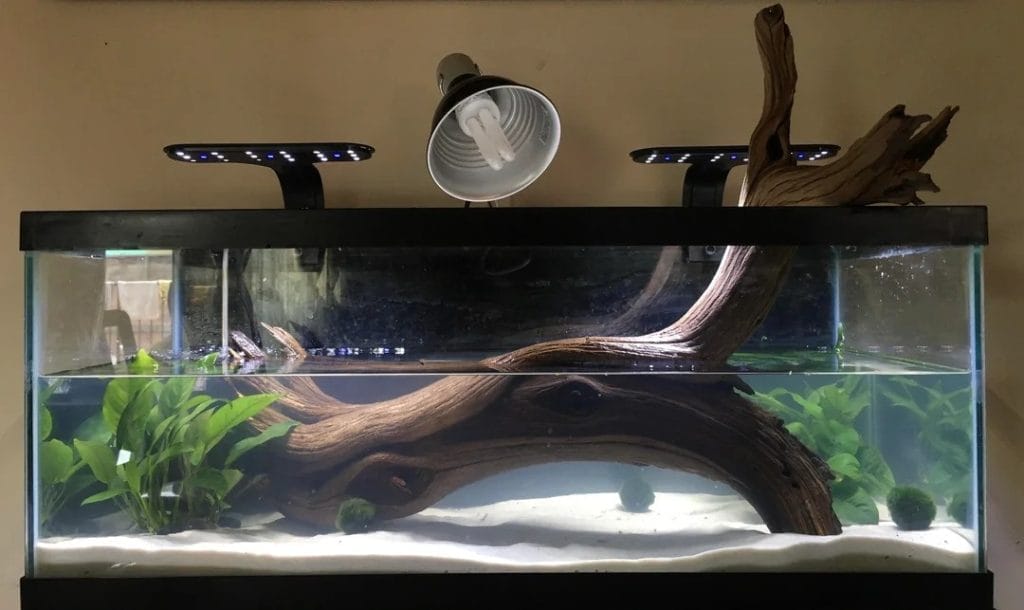Do Tortoises Like To Climb?

This post was created with help from AI tools and carefully reviewed by a human (Muntaseer Rahman). For more on how we use AI on this site, check out our Editorial Policy.
It may come to you as a surprise to see your tortoise climbing the rock or log. Get used to it anyway because tortoises are excellent climbers. But why do tortoises do the climbing? Do they enjoy the activity?
Climbing is a fun game for the tortoises, and you will spot them scaling ramps, rocks, and bowls. But sometimes, climbing becomes a survival act. For example, crowded pens, mental trauma, starvation, etc., force the pets to climb out of their habitat. Read the pet’s traits and act accordingly.
More insight into the tortoise’s climbing nature is given below.
Can Tortoises Climb?
People have this misconception that tortoises can not climb. I guess their slow nature and bulky body have led to such misbelief. We assume that tortoises can only walk on land and flat surfaces.
In reality, tortoises are excellent climbers who will scale stairs, fences, ramps, trees, cupboards, bowls, and so on. These creatures will take small steps to peddle upward on the steep surface.
But here is the thing. Tortoises can not climb very steep walls or rocks. Their grip and balance are not suitable for sheer surfaces. Instead, the pets can only handle slight slopes.
Likewise, tortoises can not just climb any height. But they are limited to rocky decoration, enclosure walls, logs, outdoor fences, etc. If the pets try something daring, they can lose their balance because of their body proportions.
Though tortoises struggle to climb up on a surface, they climb down smoothly. In fact, the pets may trip over and injure themselves because of the speed.
Why Do Tortoises Climb?
Of course, no one can say for sure why tortoises climb. But scientists have examined the pets’ behavior and come up with possible explanations. Such as,
1. Sensing The Surroundings
Climbing to a higher peak in the habitat might be a way for the tortoises to navigate the environment. You already know that these creatures have an excellent sense of direction.
Climbing the obstacles in the surrounding helps them make a mind map. This way, tortoises can easily locate the burrowing spot, foraging ground, and water sources in their locality.
2. Congested Housing System!
I have said multiple times that tortoises require a spacious enclosure. If you force them to live in narrow housing, it will affect their growth and mental health.
For instance, a community habitat in a congested pen will stress out the tortoises. As a consequence, the pets will bully each other on the territory. The lack of venting spots will make the weaker tortoises more anxious and force them to look for an escape.
In this scenario, tortoises will use their climbing skill to escape their habitat.

3. Are The Walls Low?
Tortoises are smart, curious, and adventurous. No doubt!
These pets keep trying to climb out of the pen to explore the outside world. With a low fencing or enclosure wall, tortoises may get successful in this task.
Make sure to build a high fence to prevent the tortoises from climbing out of the enclosure. A wall of at least 12″ is recommended.
4. The Glass Enclosure Is The Culprit!
In one of my previous blogs, I clarified why glass tanks are unsuitable habitats for tortoises. The transparency often makes the pets confused.
When the creatures realize there is a world beyond the enclosure, they try hard to escape. What can be a better way out of the pen than to climb it out?
Continuous failed attempts of climbing out can make the tortoises frustrated. Therefore, avoid glass-walled enclosures at all costs. Instead, go with a wooden or opaque-plastic wall pen habitat.
5. It’s Just Hunger!
In captivity, tortoises solely depend on the owners to have their meals. What happens if you forget to feed the pets for days?
Well, the starving tortoises will take charge of the situation and look for food. Their first options will be the substrates and rocks. Both are equally harmful. Next, the tortoises try to climb the walls to get outside and access meals.
6. The Environment Is New To The Pets!
Tortoise’s climbing behavior is more frequent when the creature moves to a new home. It is the pet’s way to navigate and map the new surroundings.
A tortoise takes 4 – 6 weeks to settle down in new surroundings. Once the creature gets familiar with the environment, it will be calmer.
7. Hostile & Stressful Environment
Well, we all want security, and tortoises are no different. Sometimes the lack of management can make the pets frustrated and stressed. For example, a narrow house, improper temperature, filthy surroundings, loud noise, frequent touch, etc.
In the moment of stress, tortoises look for hiding places first. Even retracting the shells is also a good defense mechanism for pets. However, if the situation goes out of hand, the creature will make an escape by burrowing or climbing out.
8. Just Looking For A Partner
Of course, tortoises do not need a companion. But these creatures can become restless during the breeding season.
The mating urges spike up in the spring, after hibernation, and last until the mid-summer. You may watch behavioral changes in the tortoises around this time. For example, pacing, burrowing, bullying, etc.
Apparently, an attempt to climb out of the enclosure is also noticed in the pets.
Usually, male tortoises have more sexual urges than females. The creatures often try climbing the walls to find a suitable mating partner.
9. It’s A Game For Them
Do not think so little of your tortoises. In reality, these creatures are smart enough to participate in games. Even tortoises get bored easily if there is nothing exciting in the enclosure.
Chasing a ball or climbing the rocks is a source of entertainment for the tortoises. The pets enjoy focusing on their small steps when climbing a surface.
10. Your Tortoise Is Born Climber
Well, some tortoises are just born climbers. For example, Russian or Horsefield tortoises are prolific climbers. They will climb on the dish, logs, or rocks in the enclosure just for fun.

This Hilarious Turtle Book Might Know Your Pet Better Than You Do
Let’s be real—most turtle care guides feel like reading a textbook written by a sleep-deprived zookeeper.
This one’s not that.
Told from the snarky point of view of a grumpy, judgmental turtle, 21 Turtle Truths You’ll Never Read in a Care Guide is packed with sarcasm, sass, and surprisingly useful insights.
And hey—you don’t have to commit to the whole thing just yet.
Grab 2 free truths from the ebook and get a taste of what your turtle really thinks about your setup, your food choices, and that weird plastic palm tree.
It’s funny, it’s honest, and if you’ve ever owned a turtle who glares at you like you’re the problem—you’ll feel seen.
Do Tortoises Enjoy Climbing?
Unfortunately, there is no correct answer to this question. Well, maybe the answer is kind of situational.
See, tortoises are natural climbers. They will walk up to any steep surface out of curiosity. Tortoises usually climb a rock, fence, or wall out of fun. This is not only an entertainment source but also a workout session for the creatures.
So yes, the tortoises thoroughly enjoy such climbings.
But then again. Climbing can be a sign of depression for the tortoises. For instance, these pets can try to escape because of improper living arrangements and frustration.
In these scenarios, climbing is not a fun task for the tortoises but an act of survival.
How High Can Tortoises Climb?
Do not expect a tortoise to climb a tall wall. The creature does not have small burs and hooks on its feet to stick to the surface. Instead, the tortoise uses its sharp claws to secure a grip on the wall solid enough to balance their body.
Considering the weight, body proportion, and strength, the tortoises can climb a 5-feet wall on average. Of course, the small tortoises may ascend only 2 – 3 feet, while the bigger ones can scale an 8 feet wall or tree.
The slope angle also influences the climbing distance a tortoise may cover. If the wall or tree is steep, the creatures will fall on its back.
Tortoises are more comfortable on slightly angled surfaces. These reptiles experience a low center of gravity on slopes, and climbing becomes easier.
What Can Tortoises Climb?
I am sure you have noticed your tortoise climbing the upside-down dish bowl or the rock inside the enclosure. Have you ever wondered what else these pets can climb? Take a look at the list,
1. Trees:
Apparently, Russian tortoises and African tortoises are prolific climbers. These species never fail to show their skill, even in the wild.
Experts have frequently spotted these tortoises climbing a tree. But why in the world will these creatures mount a tree? Well, it can be a fun activity for the tortoises, or they are trying to reach out for the fruits or leaves.
Remember, tortoises can not climb just any tree but the ones bent at a slight angle.
2. Stairs:
Honestly, scaling the stairs is too much for the tortoises because of the angle. However, these creatures can ascend or descend any stair, slightly angled. Of course, stairs are never safe for tortoises, and they can meet an accident at any time.
3. Fences:
Even though fences are flat and steep, tortoises seamlessly scale the full height. The meshed chicken wire fencing provides the perfect knots for hand grip. As a result, tortoises can easily make it out to the other side.

4. Ramps:
These platforms are slightly inclined, which is why tortoises face no issue climbing them. In fact, keepers often add ramps to the pet’s enclosure so that they can move to higher spots effortlessly.
5. Walls:
Climbing a wall is not an easy task due to the smooth surface. But if the walls are made of meshed materials, tortoises can easily mount them. However, make sure to protect the fences and walls of the habitat to prevent escaping of the pets.
How To Stop My Tortoises From Climbing?
Well, climbing is not always bad for the tortoises. In fact, in most cases, these creatures climb a rock or a bowl out of fun. Consider it as a game for them.
If your tortoise loves climbing, give them big rocks, upside-down cardboard, ramps, etc.
On the contrary to this situation, we have seen that tortoises may climb out of their habitat and escape. The main reason behind such behavior is an improper care sheet. For example, a congested tank, stress, insufficient food, constant disturbance, etc.
To prevent the unwanted climb out, here is what you can do,
- Provide the tortoises with a spacious enclosure.
- Build several hiding spots for the pets so that they can spend alone time.
- Arrange toys to entertain the tortoises.
- Maintain the right temperature and humidity inside the pen.
- In the case of community habitat, look out for the bullies.
- Do not starve the tortoises intentionally. If you are out for a vacation, install an automatic feeder.
Before You Go
Turtles, the close relatives of tortoises, also possess this climbing nature. Sometimes turtles try to climb out of the tanks intentionally. The attached article shares more details on such behavior of these creatures.
Why Does My Turtle Keep Trying To Climb Out?

About Author
Muntaseer Rahman started keeping pet turtles back in 2013. He also owns the largest Turtle & Tortoise Facebook community in Bangladesh. These days he is mostly active on Facebook.











